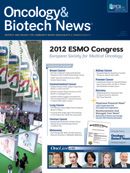Publication
Article
Oncology & Biotech News
Patient and Physician Decision Practices Influence Chemotherapy Use in Older Patients With Breast Cancer
Author(s):
Older women with breast cancer who prefer less input from their physician when deciding on treatment are less likely to receive chemotherapy than women who prefer to rely on their physician to a greater degree, a recent study has found.
Jeanne S. Mandelblatt, MD
Older women with breast cancer who prefer less input from their physician when deciding on treatment are less likely to receive chemotherapy than women who prefer to rely on their physician to a greater degree, a recent study has found.
The data also show that patients whose oncologist had a higher preference for chemotherapy had a greater likelihood of receiving chemotherapy than patients whose oncologist had a low preference.
Jeanne S. Mandelblatt, MD, associate director for Population Sciences at the Lombardi Comprehensive Cancer Center in Washington, DC, and coworkers elsewhere examined associations between patient and oncologist decision-making styles and chemotherapy use.
For their study, the investigators used data from women aged ≥65 years who were newly diagnosed with invasive nonmetastatic breast cancer (tumors ≥1 cm) from January 2004 through April 2011 at 75 hospitals or practices affiliated with the Cancer and Leukemia Group B (CALGB) cooperative group.
About half of new cases of breast cancer in the United States and nearly two-thirds of breast cancer deaths occur in women aged ≥65 years, the authors noted. Decision making about adjuvant chemotherapy in this cohort is complicated because scant evidence exists about its benefits. Also, older patients have multiple comorbidities, and there are concerns about treatment toxicity. Thus, factors such as patient and physician decision-making styles may impact treatment choices, they added.
Oncologists treating study participants were mailed a brief survey that focused on their background and practice styles. Information on patients’ tumor characteristics and treatment history were obtained from medical records.
Patient decision style was measured on a 5-point scale. Oncologist preference for prescribing chemotherapy was based on responses to four hypothetical case scenarios that described older women with nonmetastatic breast cancer and selected clinical characteristics followed by questions about the treatment the physician would select for each woman.
The analysis included 1174 women seen by 212 oncologists. Forty-three percent of women received chemotherapy. Results showed that 30% of women preferred to make their chemotherapy decisions alone or mainly alone with some input from their physician. Forty-one percent said they favored joint decision making.
Women who preferred to make their decisions with less input from their physician were significantly less likely to have had chemotherapy than women who had a preference for more input (the odds of chemotherapy decreased by 21% for each 1-point change on the decision-making scale, 95% CI, 0.65-0.97; P = .02), adjusting for covariates.
The odds of receiving chemotherapy among women whose oncologist had a high preference for recommending chemotherapy were 2.65 times higher (95% CI, 1.80- 3.89; P <.001) than the odds of receiving chemotherapy among women who were seen by oncologists with a low preference.
Patient and oncologist decision styles were not influenced by patient—physician communication.
Mandelblatt et al emphasized that optimal decision making “may remain an elusive goal” in older patients with breast cancer until there is empirical evidence about the benefits and risks of adjuvant chemotherapy.




























%20(2)%201-Recovered-Recovered-Recovered-Recovered-Recovered-Recovered-Recovered-Recovered-Recovered-Recovered-Recovered-Recovered-Recovered-Recovered-Recovered-Recovered-Recovered.jpg?fit=crop&auto=format)
%20(2)%201-Recovered-Recovered-Recovered-Recovered-Recovered-Recovered-Recovered-Recovered-Recovered-Recovered-Recovered-Recovered-Recovered-Recovered-Recovered-Recovered-Recovered.jpg?fit=crop&auto=format)
